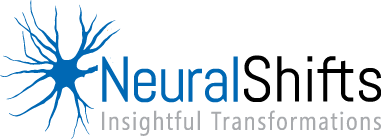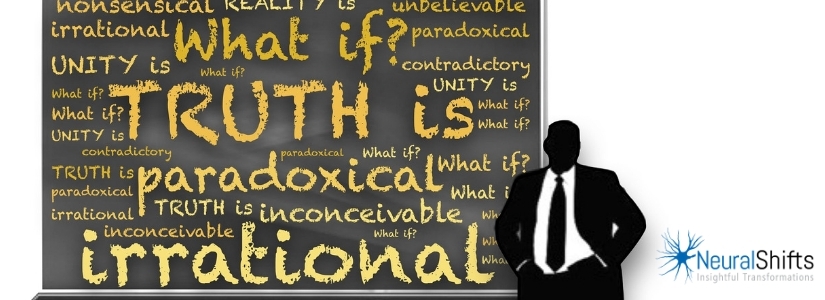Think about everyone at work for a minute. And not just where you work, but all those people in offices across the world. Now consider that each of them—every single employee—is making large and small decisions all…day…long. From answering emails to delivering a performance review, they’re constantly deciding stuff.
That’s a lot to unpack. For starters, employees’ decisions (and they make a lot of them every day) are constantly influenced by internal and external forces, not the least of which is the power dynamics inherent to corporate culture (has a way of staying top of mind, doesn’t it?). Spoiler: it’s set up that way.
Which means that if you were going to set out to re-shape and drive equitable workforces, while meaningfully improving Diversity & Inclusion practices, you’d start by examining decision making. Why do people choose what they do? And are they aware of how they’re deciding?
Bounded Rationality: The Employees We Think We Are
Most organizations have unfortunately—and unsuccessfully—assumed employees are rational people who, with the right training, will make rational hiring and promotion decisions. (One of the problems of only providing “unconscious bias training” is that no one likes to be told they’re wrong—also, that offering unconscious bias training alone doesn’t work.)
Given a choice between sleeping in and waking up early to work out, who hasn’t hit the snooze button even though we clearly understand the cost of not exercising—again? In the same way, when it comes to the workforce, we like to believe that we are fair and equitable when recruiting and promoting others. But given a choice between hiring an old school friend over a stranger with the same qualifications…well, you can probably guess who you’d be likely to choose (even if you didn’t think you were biased toward your buddy). Herbert Simons described this phenomenon as Bounded Rationality.
In short, Simons’ theory is that we make suboptimal decisions due to our reliance on rules-of-thumb, which are really just personal biases. Our brains have limited computational abilities, which becomes a factor when we take risks (you naturally need more brain space to tackle new, unfamiliar problems), so we often opt for the easiest route.
All this goes to show that the employee we think we are actually differs quite a bit from who we really are because our willingness to take risks is influenced by the way our choices are framed. In other words, our decisions are always culture-dependent; but that’s very hard to recognize. And if you think career decisions such as hiring and promotion are made in a vacuum, think again. Instead, those choices are embedded in cultural beliefs around meritocracy and cultural fit. So it probably comes as no surprise that employees at an organization with meritocratic tendencies (like pay-for-performance systems) are more likely to engage in discriminatory behavior towards women and minorities. Ouch.
It’s called the ‘Paradox of Meritocracy.’ By working in an organization that ostensibly espouses a fair and equitable culture, employees think they are more likely to be fair themselves, and are therefore less likely to examine their actions for signs of prejudice. (Think of the managers with Diversity & Inclusion mandates who say they “do not want to lower the quality of their hires” and refuse to consider gender or minority status as part of the hiring criteria.) Promotion decisions are also significantly influenced by cultural beliefs about who can succeed. (If given the power, who will act in who’s best interests?) As we’ve seen, employees’ minds are influenced by their frame when making decisions—which all too often just encourages them to compare prospect leaders to current ones. If they can’t match the data, it’s unlikely that they’ll take the risk of promoting someone who doesn’t conform to the culture standard.
On the other hand, hiring decisions anchored in cultural fit are destined to replicate biases systemwide. As a hiring manager, I’ve personally made the mistake of profiling successful employees and using that criteria to assess prospective employees—and it created a homogenous workforce that I see in retrospect lacked the ability to innovate, and deeply hindered the organization’s ability to reach a new level. I’ve since gained new awareness and adopted new practices based on Behavioral Economics [BE] principles in my work. In my next article, you’ll find out how you can do more of the same—and reap the benefits.
See follow-up article, “6 Ways to Improve D&I with BE”
To make significant progress in a diverse and equitable workforce, Diversity & Inclusion strategies must implement and champion cultural values and decision-making systems that reward power-sharing practices. One size doesn’t fit all, and each culture influences the process and outcome. Experiment, change your approach, measure the results, and let us know what progress you see.
References
Who is still biased. Boston Globe Opinion.
⦁ Iris Bohnet, What works: gender equality by design
⦁ Emilio Castilla, Achieving Meritocracy in the Workplace
⦁ Blanken, Irene & van de Ven, Niels & Zeelenberg, Marcel. (2015). A Meta-Analytic Review of Moral Licensing. Personality & social psychology bulletin. 41. 10.1177/0146167215572134.
- Nudge, Richard Thaler and Cass Sunstein
- Work Rules, Laszlo Bok




0 Comments